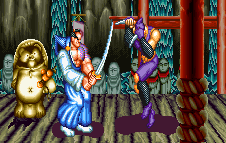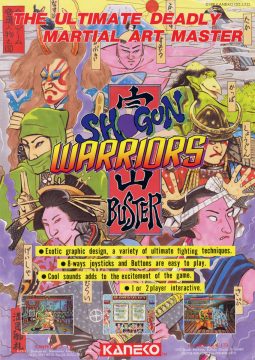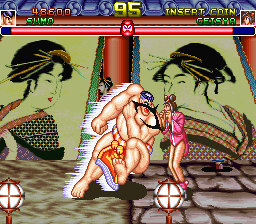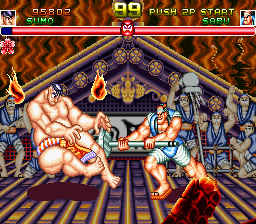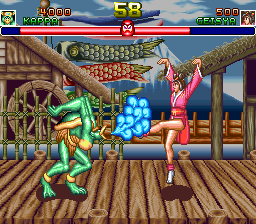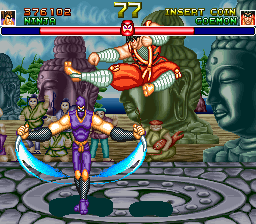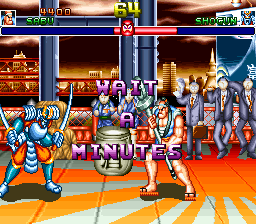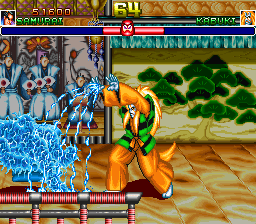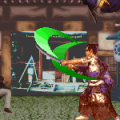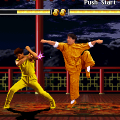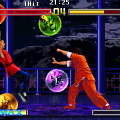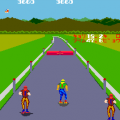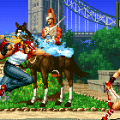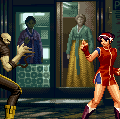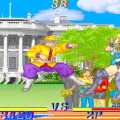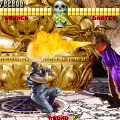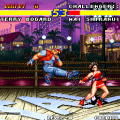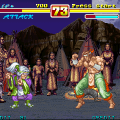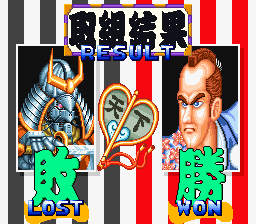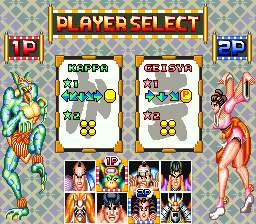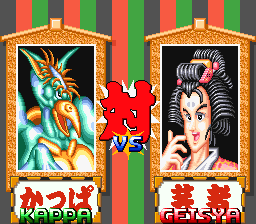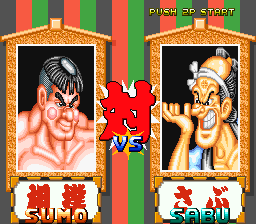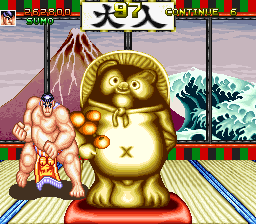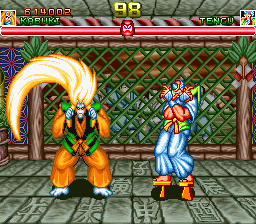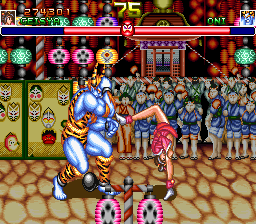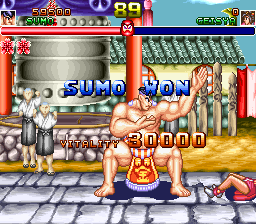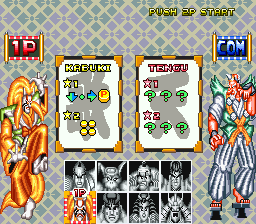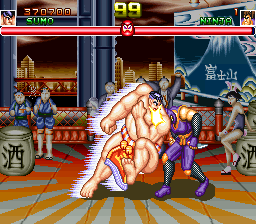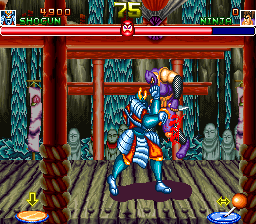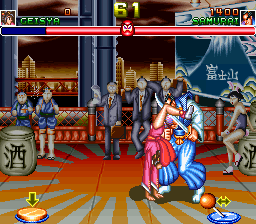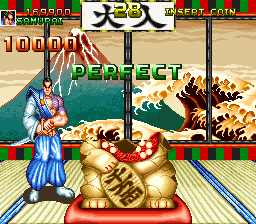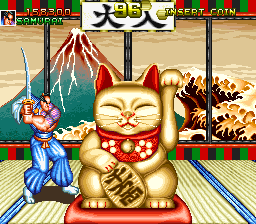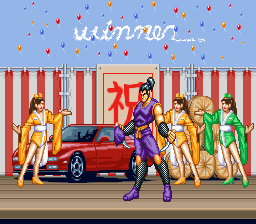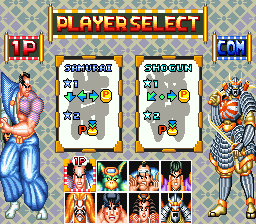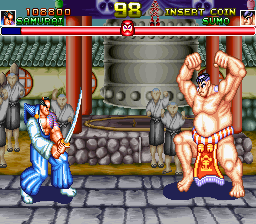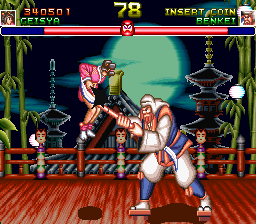- Shogun Warriors
- Blood Warrior
Once Street Fighter II: The World Warrior exploded into arcades, just about every game publisher tried to make a game like it, working usually in vain to capture the same popularity of Capcom’s now legendary series. And so a deluge of one on one fighting games hit the market with colorful graphics and flashy animations. A year later Mortal Kombat appeared in arcades to similar success but with a completely different approach. This lead to an entire line of other rip offs whose only selling points were eschewing pixel art for digitized graphics of real people like Mortal Kombat or having just as much graphic violence. One publisher, however, reached for the stars and created both a Mortal Kombat AND a Street Fighter II clone within two years of each other, even using the same characters and setting for both. Sadly, while both of Kaneko’s efforts offer some original ideas and fun characters, both are clearly rushed and unpolished in their attempts to get out and capitalize on the popularity of their inspiration as quickly as possible.
Shogun Warriors and Blood Warrior were developed by a team called Atop, a group of Kaneko regulars. These two fighting games are the only ones developed under the Atop name. While it seems like they were the last games designed by Naoki Hoshizaki after he worked on a few installments of Westone’s Wonder Boy series and the simple but excellent Aoi Blink on the PC Engine, the rest of Atop continued to work at Kaneko and in some cases with other developers later on. Masanori Yoshihara, another Aoi Blink and Wonder Boy alum, would go on to work as a designer on several games that still have a cult following today, like Blood Gear and Arcana Heart. Blood Warrior‘s bland backgrounds stand out even more knowing that they were created by Tomoko Nakayama, who later worked on much more colorful fare as a co-director of the baroque Wii exclusive Pandora’s Tower.
One of the character designers, Fumihide Aoki, would go on to have a stint at Pack-In-Video before entering into a long career with Camelot and Nintendo, contributing graphics and art direction for many installments of the Shining Force and Golden Sun series as well as Nintendo’s various Mario sports games. He has worked with Nintendo as recently as 2014, on Mario Golf: World Tour for the 3DS.
The most interesting member of Shogun Warriors‘ production, however, is Noboyuki Tanaka. He is only credited with a “Special Thanks” in Shogun Warriors, and was not involved in Blood Warrior. However, Shogun Warriors‘ visual stylings and more vibrant backgrounds make sense with his involvement. Just one year later he would work as the executive producer for Samurai Shodown. Little touches like the messengers running by in some backgrounds and other details associated with SNK’s classic series are not a coincidence after all!
All in all, twelve people are listed in Shogun Warriors‘ credits. After some departures, only ten were left to work on Blood Warrior along with just three stunt people to choreograph and perform as the characters. These three, Jyunko Abe, Tadao Yoshikawa, and Miyuki Suzuki, were members of Japan Action Club. J.A.C. is a training school for aspiring actors and martial artists that was actually formed by Sonny Chiba in the late seventies.
Both Shogun Warriors and Blood Warrior were made by some very talented creators, but both feel rushed and unpolished. With such a small team, however, they’re almost impressive. Samurai Shodown as an example, was made by almost fifty people, and with the similarities between both games, it’s easy to see how it could have been a much more memorable game if Kaneko had more effectively supported its production.
While Shogun Warriors is forgotten now, it is worth a look for fighting game fans for its campy presentation and goofy characters. Characters Kaneko had so little faith in that they weren’t even given names – they’re just referred to by occupations like Sumo, Samurai, etc. Oddly, the only actual Shogun in the game is a robot. While the title change may seem like an attempt to capitalize on the popular Samurai Shodown games, Shogun Warriors actually predates that series’ first installment by a year. In that respect, Shogun Warriors‘ characters had a brief moment when they actually were unique among fighting game rosters, a rarity in the genre that was unfortunately not enough to make up for the game’s flaws.
Characters
Geisya
Geisya seems ordinary at first, but has one of the most powerful special moves in the game, an easy to execute move where she spins around while sliding forward to hit enemies multiple times. If all four hits connect, the attack will take off 75% of an opponent’s energy! Interestingly, the design displayed for her in the character select screen is significantly different from how her sprite looks in the game.
Kabuki
Like Kyoshiro in the later Samurai Shodown series, Kabuki is a Kabuki actor that fights with this massive hair. His special moves are almost useless, but his normal attacks are some of the best in the game. Due to the versatility of their normal attacks, Kabuki and Kappa are also very good choices to fight the game’s four bosses.
Kappa
He has stretching limbs, an icy breath attack, and powerful kick moves he can use to repeatedly bounce off an opponent’s head. This is in addition to a move that lets him fly across the screen, letting him quickly get close to an enemy to grapple with them. Kaneko basically took cool things about Dhalsim and Chun Li from Street Fighter II: The World Warrior and combined them into one character. Like Geisya, his portrait looks very different from his sprite and more like a traditional depiction of a Kappa.
Ninja
Shogun Warriors‘ ninja character is similar to Kabuki, in that his special moves aren’t as useful as they seem, while his normal attacks are very good. He wears a huge shuriken on his back in case people forget that he’s a ninja.
Sabu
This guy is just a farmer wielding a post as a weapon. He has a spinning attack move similar to Geisya’s but not as fast or damaging. He’s so lame he didn’t even make it into the sequel.
Samurai
Samurai has a prominent tattoo on his shoulder, but otherwise he is super boring and, despite wielding a sword, his attacks have terrible range. Avoid.
Shogun
His background is a modern day bridge with a prominently featured Mount Fuji billboard. Like the game’s ending, Shogun’s design and his background are out of place when almost everything else in the game’s presentation sets it in the past.
Sumo
Sumo can be pretty fun to play as. All it takes to make him charge across the screen is tapping all four buttons at once. With his height, this move is meant more to knock jumping opponents out of the air with the right timing while also letting him quickly close the distance with his enemy. Unfortunately he’s missing in the sequel.
Bosses
Oni
This guy’s background shows that he draws a huge crowd. A big blue guy wearing a fur caveman outfit, he mostly attacks by spitting fire on the ground and jumping at you. His AI is coincidentally extremely similar to Goro’s in Mortal Kombat, many of the same tricks used against Goro will work just fine here. Unfortunately he didn’t make the cut for Blood Warrior.
Tengu
Despite this guy’s serene background, Kappa’s funky music is used as his theme song. The coolest of the four bosses by far and a fun challenge. Unfortunately he also didn’t make the cut for the sequel and remains exclusively in Shogun Warriors.
Benkei
A huge guy whose normal standing attacks are the best anti-air moves in the game. So he of course is also given a fast, powerful projectile attack to make him even more annoying. The most tedious fight as you have to carefully approach him and be ready to counter any move he does quickly, if he gets you in a corner it’s over.
Goemon
Benkei is the most tedious boss fight, but Goemon is by far the most frustrating. He’s also ineffectively morbid compared to the game’s other characters, pointing at the screen to inform the player personally that “You will die!” Even his design is a ridiculously “dark and gritty” version of the legendary Goemon figure.
Some of these characters are actually pretty cool for a 2D fighter released in 1992, and Kaneko deserves some credit for putting out a game so similar to SNK’s Samurai Shodown a solid year before Samurai Shodown even existed. While the game is nowhere near as good as SNK’s once popular series, it’s worth a try as an example of a competent, but unbalanced, early take on a Street Fighter II style fighting game. The animation is a little choppy but in general it looks nice. There’s also a pretty good soundtrack to go along with the action, though unfortunately some songs are used for more than one character, keeping each background and character from having as much personality as we’d see in the best fighting games from Capcom and SNK.
The most immediate flaw of Shogun Warriors is the way special moves work. It’s seemingly simple, but has a few issues that keep it from being as intuitive as Street Fighter II or even more complex fighters like Samurai Shodown II. The game is played with four buttons, two for punching and two for kicking. Each character also has a couple of special moves that can be performed by either hitting all four buttons, or by performing a motion on the joystick followed by hitting one of the punch buttons. The game even shows you each character’s special move motions on the select screen, a revelation at a time where some kind soul would often tape a hand written list of every character’s moves to the side of the arcade cabinet. The problem is that the joystick motions have to be performed with a very exact timing that few other games in the genre demand, making it difficult to execute these motions consistently. To make things even more frustrating, when an opponent is knocked away with a special move, the game does not let the player on the offensive move forward to follow up. This odd restriction often happens while performing basic attacks on opponents, removing potential strategy from the game. It’s a shortsighted decision that ends up making the game uninteresting compared to its contemporaries.
The most frustrating thing about Shogun Warriors‘ fighting, however, is the way grappling works. In other fighting games in the early nineties, it’s often easy to grab and throw an opponent by hitting a direction and a button. But here grappling is initiated by pressing either both punch buttons or both kick buttons at the same time while standing next to an enemy, then rapidly mashing the buttons to actually make the move do any damage. During this time the player on the receiving end has to quickly move the joystick left and right in an attempt to break out of it. This is a mess in practice. For some characters, the grappling attack involves them grabbing and striking an opponent repeatedly, letting them easily cause a little damage even if the opponent breaks out quickly. Other grapple attacks consist of a single hit that has to be built up to and will almost never be seen because of how hard it can be to out-mash the opponent. It also completely wrecks the game’s balance when fighting against the AI, as it is often simply too fast to escape unscathed, especially when it comes to fighting the game’s four bosses.
When Kaneko released Shogun Warriors outside of Japan, it was given an English dub. SNK did this with some characters in Art of Fighting 2, but otherwise this was very uncommon at the time. The effort is appreciated, but the result is more amusing than coherent. In the US release, Sumo excruciatingly exclaims “I’m strong!” in an unidentifiable accent. The most hilarious however is Geisya. During one of her special moves it sounds like she’s screaming “What a fucker!” – in US arcades in 1992! If she is actually saying “sucker,” the low sampling quality of the game makes it impossible to hear it that way. Another stand out is Kabuki shouting “Wyld Stallyns!” as he does his head banging special move.
